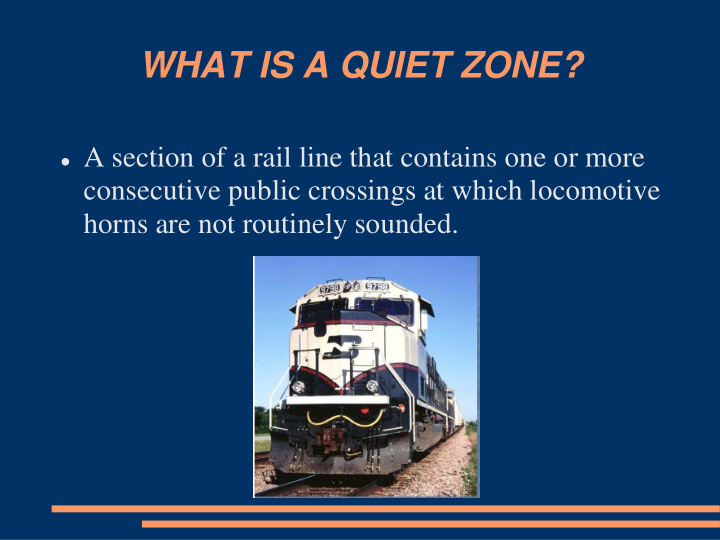



WHAT IS A QUIET ZONE? A section of a rail line that contains one or more consecutive public crossings at which locomotive horns are not routinely sounded.
WHY HAS THE FRA ISSUED THE TRAIN HORN RULE? To require trains to sound a locomotive horn at public grade crossings To permit the creation of Quiet Zones To promote quality of life without compromising safety
FRA FINAL RULE Issued April 27, 2005 Rule became effective June 24, 2005 Requires horns to be sounded to warn motorists at public crossings Provides exceptions where risk is minimized Enables communities to establish quiet zones by reducing the risk caused by lack of horns
CHANGES IN TRAIN HORN REQUIREMENTS Requires the sounding of locomotive horns when approaching every public crossing (replacing state law) The horn shall be sounded no greater than ¼ mile from the crossing and at least 15 seconds, but no more than 20 seconds, prior to the train entering the crossing Sec. 229.129 defines minimum and maximum train horn decibel levels (96dB-110dB)
WHO CAN ESTABLISH A QUIET ZONE? Public authority with jurisdiction for the roadway at the crossing If the Quiet Zone includes more than one public authority, all agencies must agree and actions must be taken jointly Quiet Zones may be established irrespective of state law
HOW ARE QUIET ZONES CREATED? Local governments will have two ways of creating a quiet zone: − Show that the lack of the horn does not pose a significant safety risk − Implement safety measures such as SSMs (Supplementary Safety Measure) or wayside horns to reduce excess risk associated with no horn
FOUR TYPES OF QUIET ZONES Pre-Rule Quiet Zones: − Areas without train horns on October 9, 1996 and on December 18, 2003 Intermediate Quiet Zones: − Areas without train horns after October 9, 1996 and before December 18, 2003 New Quiet Zones: − Quiet Zones that do not qualify as Pre-Rule or Intermediate Quiet Zones Partial Quiet Zones: − A Quiet Zone where the train horns are not routinely sounded for a specified period of time (10p.m.-7a.m.)
SSM – SUPPLEMENTAL SAFETY MEASURES Temporary Closures Four-Quadrant Gates Gates with Medians or Channelization Devices One-way Streets with Gates
WHAT IS A WAYSIDE HORN? A stationary horn located at a highway-rail grade crossing, designed to provide, upon the approach of a locomotive or train, audible warning to oncoming motorists of the approach of a train. − One-for-one substitute for the train horn − Can be used within or outside of a QZ − Simplest way to reduce train horn noise
CONSIDERATIONS FOR USE OF WAYSIDE HORNS Temporary closure is not feasible Not enough distance to implement raised medians One-way street is not a viable alternative Cost of four-quadrant gates is prohibitive Cost effective for the community
FOUR-QUADRANT GATES -Block access from all lanes -Require additional railroad circuitry
MEDIAN DIVIDERS -At least 100 feet in length -60 feet if at intersection Either: -Non-mountable curbs -Mountable with channelization devices
WAYSIDE HORN -Quieter, but not silent -Reduce area impacted by sound of horn -Sound directed at roadway -Requires a pre-emption circuit from rail road
WAYSIDE HORN VS. TRAIN HORN -Directs sound toward roadway -Impacts a smaller area
ESTIMATED COST PER CROSSING (all crossing are required to have flashing lights and gates) Four-quadrant gates $200,000 Wayside horns $30,000 Median barriers $15,000
CITY OF O'FALLON QUIET ZONE PLAN
TO CREATE A QUIET ZONE Select the appropriate safety devices for crossings Run FRA Quiet Zone Calculator Schedule any necessary railroad signal work with the railroad Install the safety devices Update the federal grade crossing inventory for the crossing File notices with the federal and local agencies and railroad Install “Horn Will Not Sound” signs for the motorists
The new QUIET ZONE regulations allow communities to maintain railroad crossing safety while reducing train noise. NOTE: Pictures and some illustrations from the Woodharbor Associates and the Railroad Controls Limited
RECOMMENDATIONS Divide into two phases: • Phase I. Include Main St., Sonderen, & Westholf • Phase II. Include Elaine Dr., Genteman Rd/Forest Acres, McGee Rd. & Hoff Rd.
PHASE I TREATMENT A Main St. (wayside horn) Sonderen (wayside horn) Westhoff Rd. (closure) Annual maintenance fee ??? With these qualifying devices, it would cost about $60,000 each crossing or $120,000
PHASE I TREATMENT B Main St. (4 quadrant crossing) Sonderen (medians) Westhoff Rd. (closure) No annual maintenance fee With these qualifying devices, it would cost about$260,000 (4 quad.) plus $15,000 median for a total cost of $275,000.
PHASE I TREATMENT C Main St. (median) Sonderen (median) Westhoff Rd. (closure) No annual maintenance fee With these qualifying devices, it would cost about $15,000 at each crossing for a total of $30,000.
WHY HAVE A QUIET ZONE? Improves overall quality of Life: -good nights sleep, which helps heal ailments & illnesses and improves ones judgment -working environment Improves property value: -Increases homeowner's equity -Increases city's coffer
FINANCING THE PROJECT Form a Neighborhood Improvement District Area of about 2500 homes & would be bounded by: − North: Tom Ginnever − South: I-70 − East: TR Hughes − West: Woodlawn − NID put on ballot by city council or petition of 2/3 property owners within the proposed district. City Coffer
COSTS TO HOMEOWERS Wayside Horns: -Each home either pay one time fee of $60 or with a 20 year loan about $6 per year. Medians: -Each home either pay one time fee of $30 or with a 20 year loan about $3 per year. Mixed Devices: -Each home either pay one time fee of $120 or with a 20 year loan about $12 per year. ($300,000 project, 20 year loan at 6% would be $2,150) All above costs does not include business.
Recommend
More recommend